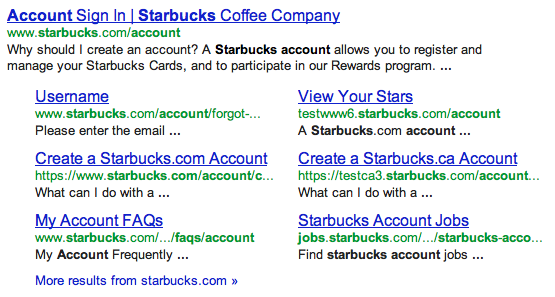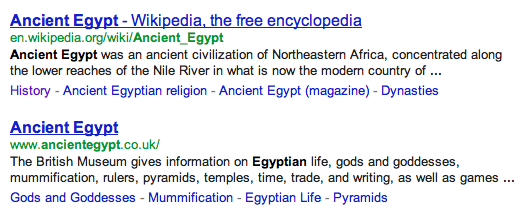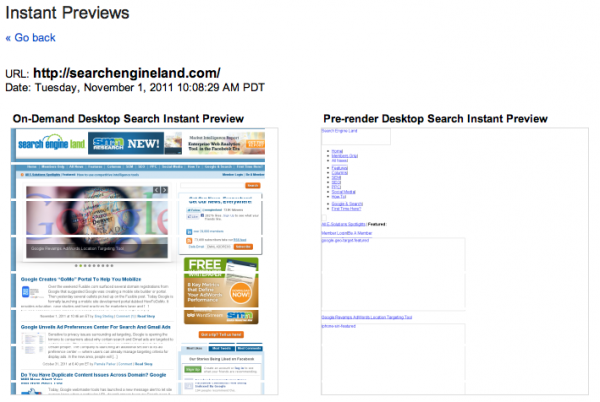The Clickthrough Rate Equation In Organic Search, Part Two
In last month’s post, I talked about how improving organic clickthrough rate multiplies the effectiveness of the other work that goes into optimizing a website for search, such as keyword research, SEO, and usability. Most of these ways of increasing clickthrough rate are directly in our control by tweaking the on-page code. I ended by covering […]
In last month’s post, I talked about how improving organic clickthrough rate multiplies the effectiveness of the other work that goes into optimizing a website for search, such as keyword research, SEO, and usability. Most of these ways of increasing clickthrough rate are directly in our control by tweaking the on-page code.
I ended by covering the two most important components of the search result: titles and snippets.
In this post, I’m going to cover some of the other search result components that can also improve clickthrough rate.
The Green Text
URLs
I have noticed that some sites like to put lots of keywords in their URLs so that they will show up in the search results. (And possibly because they believe is helps with ranking, which is a separate issue.) Using keyword-rich URLs is fine as long as you take the following into consideration:
- Don’t do this if your URL path elements are actually URL query parameters.
- For example, you have a URL like https://www.example.com/t-shirt-id/1234/page/4 that was rewritten from a URL like https://www.example.com/product.php?t-shirt-id=1234&page=4. If you do, you are risking serious crawl efficiency issues because search engines can’t normalize path elements the way that they can with query parameters.
- Make sure that you aren’t inadvertently causing any case-insensitivity issues or duplicate content issues.
- I see a lot of sites that will return the same page for a URL like https://www.newssite.com/it-doesn’t-matter-what-you-put-here-12345 and the real canonical URL like https://www.newssite.com/kim-kardashian-files-for-divorce-12345. Be sure to use a 301 redirect or at least a link rel=canonical URL to normalize pages like these.
- Don’t change all of the URLs on your site just for the sake of putting keywords in them. A significant site re-architecture like that is difficult to pull off without any hiccups.

Breadcrumbs
These breadcrumbs are great not only because they contain relevant keywords, but also because they give a sense of how the page you are thinking about clicking on fits in to the rest of the site. This will make it easier for users to navigate your site and make it more likely for them to convert.
Here are the corresponding breadcrumbs on the pages from the two search results above:
Thinkgeek.com:
Redbubble.com:
It isn’t possible to put together just any set of links and have search engines pick them up. At a minimum the links and link text need to:
- be canonical
- be relevant
- be short (no more than 3 or 4 words)
- most importantly, represent the actual navigable hierarchy of the site.
Google and Bing list their recommended best practices for breadcrumbs and describe the mark up language on this Google help page and this Bing help page. Both support microdata and RDFa. Schema.org also has support for a breadcrumb property if you are throwing in with microformats.
Structured Markup
RDFa, Microformats, Microdata
Structured markup can be used to explicitly indicate specific types of data to search engines. According to my notes from SMX East in September, these are supported:
- Bing and Google: reviews, people, recipes
- Google: products, events, music, and apps
- Yahoo, Bing, and Google: Schema.org, which has a zillion types of data to annotate but which has limited support currently because it was recently announced in June of this year.

Every site I have spoken with or that has presented at a session I’ve attended has indicated a large increase in click through rate after implementing their markup, especially for reviews and recipes. (One example: Topher Kohan of CNN mentioned at SMX East that adding hRecipe markup to one of their sites resulted in a 22% increase in traffic.)
Selecting the right type of markup and implementing it is an entire post in itself, so I’m going to recommend that if you have content of a type listed above, you should read through Google’s help article on rich snippets and structured data and the schema.org site.
Also, check out this great article by Aaron Bradley that gets into potential relevancy effects of marking up your pages with structured data.
Rel=author/me attributes
Indicating the author with structured markup on an article or blog post shows a profile picture along with a link to the author’s Google Plus profile page.
Setting this up requires a few steps that weren’t immediately clear to me, although Rick DeJarnette explained it well in How To Create Your Digital Footprint With Links, it involves setting attributes on three links:
- rel=”author” on the link from the article to your general author page (for example, https://searchengineland.com/author/danny-sullivan)
- rel=”me” on the link from your general author page to your Google Profile page (https://profiles.google.com/<big-long-number>)
- rel=”me” or rel=”contributor-to” on the link from your Google profile page to your general author page. To do this find your Google profile, click edit profile, and edit “Contributor to” to add a link to your general author page.
Sitelinks
Sitelinks are the block of related extra links that show up under a top search result. It’s a good idea to check these sitelinks periodically by searching for your most popular branded searches on Google and Bing.
If you see links you don’t like on Google, you can “demote” them by logging into Google Webmaster Tools and going to Site configuration > Sitelinks. The demotion will only last for 90 days.
As motivation to check your sitelinks, here is an unfortunate set of sitelinks that I found last week when trying reset my Starbucks account password:
(Aside to anyone at Starbucks: I’m pretty sure this is happening because of the way your site returns a 200 and redirects for certain types of “page not found” pages. Contact me, and I’ll send you more information. By the way, I will work for coffee.)
Sitelinks can also occur within search results, not just at position one. For example, these two search results for the query [ancient egypt] show up with their own abbreviated sitelinks:
The standard advice for getting sitelinks to show up — again from my SMX East notes — is to make sure they are “prominent links on your site.” This Google help article also recommends making sure the links have anchor text that is “informative, compact, and avoids repetition.”
Table of content links within the same page
If your site has a lot of long, technical articles or other well-structured content that generally lends itself to having a table of contents, using fragment identifiers (also called named anchors) is a really great way to get additional links with keywords to show up in search results.
Here is an example from the query [exoplanet gravitational microlensing]:
Bing also has support for this as seen from this search for [ancient egypt]:
To increase the chances of having these show up make sure your pages are well-structured, the anchors have descriptive text, and that the pages have a table of contents with links to each individual anchor.
The table of contents containing the fragments doesn’t have to take up a lot of space on the page. Here is an example from a professor’s personal site that I thought was interesting:
This is the section of the page containing the table of contents:
Miscellaneous Tips
Rank higher
Ranking higher in the search result pages will result in a higher clickthrough rate, but that’s out of our direct control and a little beyond the scope of this post.
Character encoding
Occasionally, I see a site with character encoding issues. Usually it results from having the server configured for one character encoding while the page templates and/or the underlying database are configured with different character encoding.
Aside from server configuration issues, I’ve seen this happen with sites that include data from 3rd party sources with varying character encoding and when documents are copied and pasted from Word directly into webpages.
If character encoding issues surface on your site, it will definitely reduce click through. Compare this result:
with this one:
I faked this one by deliberately setting my browser to the wrong character encoding, but I have seen issues like this on sites. Generally, I recommend doing everything in UTF-8 as much as possible.
Instant Previews (Google)
In November 2010 Google started showing instant previews, which pops up a preview of the web page in the search results when you hover over the result. The announcement makes the claim that people who use them are “5% more likely to be satisfied with the results that they click.” We’ll take it.
You can test out your instant previews in Google Webmaster Tools at Labs > Instant Previews. There you can find out if Google is able to pre-render its instant previews or if it has to generate them on the fly. You can also see what your instant previews on mobile search look like.
If your CSS and JavaScript files are robotted out, like they are in Search Engine Land, Google will have to generate the preview on the fly, and you will see something like this in Google Webmaster Tools:
Notice how the one on the right has no formatting, like it’s a text-only cached version of the page. I didn’t notice any delay when viewing Search Engine Land’s instant preview, but I would still recommend that Google be allowed by pre-render these instant previews.
For more information check out Google’s very useful FAQ on instant previews, which is on a separate Google Sites page for some reason.
Social Signals
This is another area that is out of our direct control, but it shows some of the benefits that a good social media program can have on an organic campaign. Having friends and colleagues recommend links that show up in your search results can only increase clickthrough rate.
Bing integration with Facebook
Bing has excellent integration with Facebook, which annotates your search results with friends who have recommended the same pages. As an example, on a Bing search for [bay area college radio], I see that four of my friends recommend the venerable college station KFJC 89.7.
Google integration with everything but Facebook
With Google, depending on how the person who is searching has filled out his or her profile, you can get recommended results from Google+, Twitter, Blogger, and Buzz. I have even seen results that were recommended to me because someone I am linked to via Gmail shared it.
A recommendation from Blogger showing up in a search for [kfjc]:
A recommendation from Google+ showing up in a search for [google profile]:
Conclusion
I hope that this quick run through of different techniques that can affect how your pages show up in search results — URLs, breadcrumbs, structured markup, author tagging, sitelinks, named anchors, instant previews, correcting character encoding issues, and social signals — gives you at least a few ideas of how to increase your site’s clickthrough rate, which will multiply the effects of all the other optimizations you are doing on your site.
Contributing authors are invited to create content for Search Engine Land and are chosen for their expertise and contribution to the search community. Our contributors work under the oversight of the editorial staff and contributions are checked for quality and relevance to our readers. The opinions they express are their own.
Related stories
New on Search Engine Land














